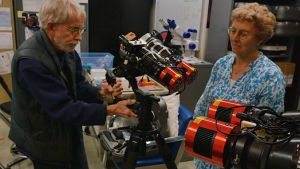To catch a glimpse of the next total solar eclipse on December 4, sky gazers will have to trek to the icy continent of Antarctica. University of Hawaiʻi Institute for Astronomy (IfA) Astronomer Shadia Rifai Habbal and her eclipse team, the Solar Wind Sherpas, are one of a small handful of scientific teams traveling to the remote South Pole to carry out scientific observations. The 14-member team is busy testing equipment before they depart Hawaiʻi on November 22 and 24.
They’ve chased eclipses around the globe, however, this winter—for the first time—their only observing option is at sea, and their plan is to conduct studies from a cruise ship.
“The sun is the closest star we can study in detail, and it’s really our gateway to other stars,” said Habbal. “So anything we can learn about the sun and its outer atmosphere, the corona, impacts a tremendous part of astronomy and many other fields in astronomy.”
A Solar Wind Sherpa first

Habbal has led her team on 16 eclipse expeditions across the world, but this will be the first one they’ll study while on water. The team has prepared by testing equipment aboard the Majestic, a 150-foot yacht belonging to local company Atlantis Cruises. To operate on a swaying boat deck, scientific equipment must be mounted on stabilizing platforms. Weather conditions during the December expedition will also play a major factor in the quality of observations.
During a total solar eclipse, the Sun, Moon and Earth align. It’s a sight that supercharges IfA graduate student, Sage Constantinou. The upcoming event will mark his third eclipse expedition.
“It’s unlike anything you can imagine. The whole sky goes dark, everything gets cold. You wouldn’t think, instantaneously, the air temperature drops,” Constantinou said. “All the animals in the region just start freaking out, birds, dogs, everything. The sky just lights up with the Sun’s corona.”
How eclipse observations reveal impacts to Earth
Observations of the awe-inspiring event can help broaden understanding of space weather and enhance GPS and satellite communications. During the 2020 eclipse in Argentina, the team discovered a solar eruption that formed a double bubble shape. They observed how it triggered measurable changes in the temperature distribution and density of the Sun’s corona. These events originating on the Sun’s surface can devastate the world’s power grid, and impact astronauts in orbit, so fully understanding their nature is important.
There are many ways to study the solar corona, from spacecraft, to ground-based solar telescopes, but solar eclipses provide a superior opportunity. Even amateur data from consumer-grade cameras can produce scientifically useful imaging. In the past, Habbal and her team have combined their findings with amateur data- however there’s little chance of that this round, given the remoteness of this eclipse.
This research is an example of UH Mānoa’s goal of Enhancing Student Success (PDF), Excellence in Research: Advancing the Research and Creative Work Enterprise (PDF), two of four goals identified in the 2015–25 Strategic Plan (PDF), updated in December 2020.

